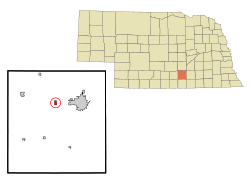Juniata, Nebraska facts for kids
Quick facts for kids
Juniata, Nebraska
|
|
|---|---|
|
Village
|
|

Downtown Juniata and grain elevators, June 2010
|
|

Location of Juniata, Nebraska
|
|
| Country | United States |
| State | Nebraska |
| County | Adams |
| Area | |
| • Total | 0.68 sq mi (1.75 km2) |
| • Land | 0.68 sq mi (1.75 km2) |
| • Water | 0.00 sq mi (0.00 km2) |
| Elevation | 1,965 ft (599 m) |
| Population
(2020)
|
|
| • Total | 744 |
| • Estimate
(2021)
|
740 |
| • Density | 1,094/sq mi (425.1/km2) |
| Time zone | UTC-6 (Central (CST)) |
| • Summer (DST) | UTC-5 (CDT) |
| ZIP code |
68955
|
| Area code(s) | 402 |
| FIPS code | 31-24950 |
| GNIS feature ID | 2398318 |
Juniata is a small village located in Adams County, Nebraska, in the United States. It is part of the Hastings, Nebraska area. In 2020, about 744 people lived there. Juniata is special because it is the oldest town in Adams County!
Contents
History of Juniata
Juniata was named by the Burlington Railroad after a river in Pennsylvania. It was founded in late 1871. Juniata quickly became the first county seat of Adams County. A county seat is the main town where the local government offices are.
The first school district in the county was started in Juniata. The county's first newspaper, the Adams County Gazette, was also published there. In the 1870s, the Commercial Hotel in Juniata was one of the biggest hotels in Nebraska, west of Lincoln.
The County Seat War
In 1872, another railroad wanted to build tracks through Juniata. However, the county leaders did not agree to their terms. So, the railroad built its tracks seven miles east and started a new town called Hastings.
This led to a "Great County Seat War" that lasted five years! In September 1878, Hastings won, and the county seat moved there. Even after losing its county seat status, Juniata continued to grow. Today, it has more residents than it did in the 1880s.
Challenges and Growth
Juniata has faced some tough times, including several big fires. The last major fire was in 1961. In 1960, a tornado destroyed a two-story town pump and bandstand that had been built in 1904.
Because it is so close to Hastings, Juniata is now mostly a commuter suburb. This means many people who live in Juniata travel to Hastings for work or other activities.
Geography of Juniata
Juniata is a small village. According to the United States Census Bureau, the village covers a total area of about 0.68 square miles (1.75 square kilometers). All of this area is land.
Population and People
| Historical population | |||
|---|---|---|---|
| Census | Pop. | %± | |
| 1880 | 494 | — | |
| 1890 | 528 | 6.9% | |
| 1900 | 543 | 2.8% | |
| 1910 | 471 | −13.3% | |
| 1920 | 329 | −30.1% | |
| 1930 | 367 | 11.6% | |
| 1940 | 338 | −7.9% | |
| 1950 | 365 | 8.0% | |
| 1960 | 422 | 15.6% | |
| 1970 | 480 | 13.7% | |
| 1980 | 703 | 46.5% | |
| 1990 | 811 | 15.4% | |
| 2000 | 693 | −14.5% | |
| 2010 | 755 | 8.9% | |
| 2020 | 748 | −0.9% | |
| 2021 (est.) | 740 | −2.0% | |
| U.S. Decennial Census | |||
Juniata's Population in 2010
In 2010, the village of Juniata had 755 people living in 299 households. About 36.5% of these households had children under 18 years old.
The average age of people in Juniata was about 39.7 years.
- 26.2% of residents were under 18 years old.
- 9.5% of residents were 65 years or older.
- The population was almost evenly split between males (51.8%) and females (48.2%).
Notable People from Juniata
- George Jay Lapp, a Mennonite bishop.
See also
 In Spanish: Juniata (Nebraska) para niños
In Spanish: Juniata (Nebraska) para niños

